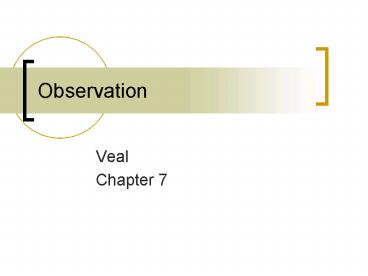Observation - PowerPoint PPT Presentation
1 / 20
Title:
Observation
Description:
Observation Veal Chapter 7 The nature of observation Observation involves looking! Generally no involvement with the observed (who may not even be aware that they are ... – PowerPoint PPT presentation
Number of Views:377
Avg rating:3.0/5.0
Title: Observation
1
Observation
- Veal
- Chapter 7
2
(No Transcript)
3
The nature of observation
- Observation involves looking!
- Generally no involvement with the observed (who
may not even be aware that they are being
observed) - Observation can also be structured observation
methods
4
Spatial or functional
- Outdore
- Entrances
- Parking areas
- People often locate themselves along edges
such as walls, fences, banks, areas of trees - The pattern of use of a site
5
Spatial or functional
- Built up areas
- Shopping malls
- Buildings
- Museums
- Another example is space management in the
supermarket
6
(No Transcript)
7
Designing areas
- In reality people do not behave as the designers
thougth they would do! - Some spaces are under-used and some are over
crowded - Or spaces are used for other activities
- The patterne of movement in an exhibition can
affect the information absorbed
8
Observations Use of a Park
9
Categories
10
System of Coding
11
Finding user profiles
- Often preliminary observations can be used to
identify features of a user profile - Makes it easier to pose the right questions in a
questionaire or an interview
12
Leisure on the margins
- Recreational drugs
- Grafitti and vandalism
- Various types of sexual activity
- Gambling
- Crowd behavior
13
Main elements
- 10-step model for structured observation
- Site
- Observation point
- Time-periods
- Sampling
- Frequency
- Zones
- Etc.
14
Step 1 and 2
- Make an inspection of the site at first to
- Choose the the site to observe
- Obervation points and
- Siutable conditions for the observation
15
Step 3, 4 and 5
- Step 3 Important
- Variations in use of facilities
- Step 4 Continuos or sampling?
- Ressources available
- The nature of the site
- Overall design of the project
- Step 5 Count frequency
- Depending on the rate of change in the use of the
site
16
Step 6
- Step 6 What to observe?
- People and their positions
- Different types of activities
- Visitor characteristics
- Visitors movements
- Flows in general
- Routes of visitors
17
Step 7
- Step 7 Division of site into zones
- Focus on each zone to decide activities etc.
- Zones should be determined by management concerns
- Ideally zones
- Can be observed from one spot and are
- Demarcared by natural (or other) features
18
Step 8
- Step 8 Recording observational information
- Make a structured counting sheet
- Makes data ready for analysis, presentation and
spread sheets - Copies of maps
- Free form notes
19
Step 9
- Conducting the observation
- Structured observations
- The main danger can be boredom
- Important to vary work
- Unstructured observations
- The observer is required to observe and describe
what is going on and at the same time - Determine what to observe
20
Step 10
- Step 10 Analysing data
- Structured observations
- Visual presentations
- Usage patterns
- Spot count data
- Weighting
- Unstructured observations
- Readable notes
- Transcripts































